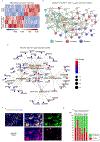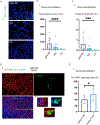CD4+ and CD8+ cytotoxic T lymphocytes may induce mesenchymal cell apoptosis in IgG4-related disease
- PMID: 32485263
- PMCID: PMC7704943
- DOI: 10.1016/j.jaci.2020.05.022
CD4+ and CD8+ cytotoxic T lymphocytes may induce mesenchymal cell apoptosis in IgG4-related disease
Abstract
Background: IgG4-related disease (IgG4-RD) is an immune-mediated fibrotic disorder that has been linked to CD4+ cytotoxic T lymphocytes (CD4+CTLs). The effector phenotype of CD4+CTLs and the relevance of both CD8+ cytotoxic T lymphocytes (CD8+CTLs) and apoptotic cell death remain undefined in IgG4-RD.
Objective: We sought to define CD4+CTL heterogeneity, characterize the CD8+CTL response in the blood and in lesions, and determine whether enhanced apoptosis may contribute to the pathogenesis of IgG4-RD.
Methods: Blood analyses were undertaken using flow cytometry, cell sorting, transcriptomic analyses at the population and single-cell levels, and next-generation sequencing for the TCR repertoire. Tissues were interrogated using multicolor immunofluorescence. Results were correlated with clinical data.
Results: We establish that among circulating CD4+CTLs in IgG4-RD, CD27loCD28loCD57hi cells are the dominant effector subset, exhibit marked clonal expansion, and differentially express genes relevant to cytotoxicity, activation, and enhanced metabolism. We also observed prominent infiltration of granzyme A-expressing CD8+CTLs in disease tissues and clonal expansion in the blood of effector/memory CD8+ T cells with an activated and cytotoxic phenotype. Tissue studies revealed an abundance of cells undergoing apoptotic cell death disproportionately involving nonimmune, nonendothelial cells of mesenchymal origin. Apoptotic cells showed significant upregulation of HLA-DR.
Conclusions: CD4+CTLs and CD8+CTLs may induce apoptotic cell death in tissues of patients with IgG4-RD with preferential targeting of nonendothelial, nonimmune cells of mesenchymal origin.
Keywords: CD28(lo); CD28(null); CD4(+)CTL; CD8(+)CTL; IgG(4)-RD; apoptosis.
Copyright © 2020 American Academy of Allergy, Asthma & Immunology. Published by Elsevier Inc. All rights reserved.
Conflict of interest statement
Disclosure statement: The authors have declared that no conflicts of interest exist.
Figures








Similar articles
-
A CD8α- Subset of CD4+SLAMF7+ Cytotoxic T Cells Is Expanded in Patients With IgG4-Related Disease and Decreases Following Glucocorticoid Treatment.Arthritis Rheumatol. 2018 Jul;70(7):1133-1143. doi: 10.1002/art.40469. Epub 2018 May 20. Arthritis Rheumatol. 2018. PMID: 29499100 Free PMC article.
-
Clonal expansion of CD4(+) cytotoxic T lymphocytes in patients with IgG4-related disease.J Allergy Clin Immunol. 2016 Sep;138(3):825-838. doi: 10.1016/j.jaci.2015.12.1330. Epub 2016 Mar 11. J Allergy Clin Immunol. 2016. PMID: 26971690 Free PMC article.
-
IL-7 Promotes the Expansion of Circulating CD28- Cytotoxic T Lymphocytes in Patients With IgG4-Related Disease via the JAK Signaling.Front Immunol. 2022 Jul 7;13:922307. doi: 10.3389/fimmu.2022.922307. eCollection 2022. Front Immunol. 2022. PMID: 35874706 Free PMC article.
-
Clonally expanded cytotoxic CD4+ T cells and the pathogenesis of IgG4-related disease.Autoimmunity. 2017 Feb;50(1):19-24. doi: 10.1080/08916934.2017.1280029. Autoimmunity. 2017. PMID: 28166682 Free PMC article. Review.
-
[IgG4-related disease -Mechanistic insights from both clinical and immunologic understanding of this condition].Nihon Rinsho Meneki Gakkai Kaishi. 2017;40(3):206-212. doi: 10.2177/jsci.40.206. Nihon Rinsho Meneki Gakkai Kaishi. 2017. PMID: 28747608 Review. Japanese.
Cited by
-
T Cell Roles and Activity in Chronic Sclerosing Sialadenitis as IgG4-Related Disease: Current Concepts in Immunopathogenesis.Autoimmune Dis. 2022 Jun 20;2022:5689883. doi: 10.1155/2022/5689883. eCollection 2022. Autoimmune Dis. 2022. PMID: 35769404 Free PMC article. Review.
-
Immune Dysregulation in IgG4-Related Disease.Front Immunol. 2021 Sep 1;12:738540. doi: 10.3389/fimmu.2021.738540. eCollection 2021. Front Immunol. 2021. PMID: 34539675 Free PMC article. Review.
-
Expansion of CD4+ cytotoxic T lymphocytes with specific gene expression patterns may contribute to suppression of tumor immunity in oral squamous cell carcinoma: single-cell analysis and in vitro experiments.Front Immunol. 2023 Nov 23;14:1305783. doi: 10.3389/fimmu.2023.1305783. eCollection 2023. Front Immunol. 2023. PMID: 38077321 Free PMC article.
-
Immune dysregulation in immunoglobulin G4-related disease.Jpn Dent Sci Rev. 2023 Dec;59:1-7. doi: 10.1016/j.jdsr.2022.12.002. Epub 2023 Jan 9. Jpn Dent Sci Rev. 2023. PMID: 36654676 Free PMC article. Review.
-
Case Report: Diagnosis of Petrous Apex IgG4-Related Disease by Middle Cranial Fossa Craniotomy and Temporal Bone Biopsy.Front Neurol. 2022 Jun 9;13:874451. doi: 10.3389/fneur.2022.874451. eCollection 2022. Front Neurol. 2022. PMID: 35756934 Free PMC article.
References
-
- Kamisawa T, Zen Y, Pillai S, Stone JH. IgG4-related disease. Lancet. 2015;385:1460–71. - PubMed
-
- Stone JH, Zen Y, Deshpande V. IgG4-related disease. N Engl J Med. 2012;366:539–51. - PubMed
-
- Wallace ZS, Naden RP, Chari S, Choi HK, Della-Torre E, Dicaire J-F, et al. The 2019 American College of Rheumatology/European League Against Rheumatism classification criteria for IgG4-related disease. Ann Rheum Dis. 2020;79:77–87. - PubMed
-
- Deshpande V, Zen Y, Chan JK, Yi EE, Sato Y, Yoshino T, et al. Consensus statement on the pathology of IgG4-related disease. Mod Pathol. 2012;25:1181–92. - PubMed
-
- Carruthers MN, Topazian MD, Khosroshahi A, Witzig TE, Wallace ZS, Hart PA, et al. Rituximab for IgG4-related disease: a prospective, open-label trial. Ann Rheum Dis. 2015;74:1171–7. - PubMed
Publication types
MeSH terms
Substances
Grants and funding
LinkOut - more resources
Full Text Sources
Other Literature Sources
Research Materials
Miscellaneous

